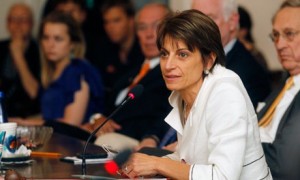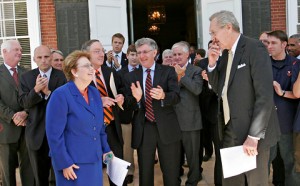Stunning the campus, the state and higher education, the University of Virginia’s governing board forced the resignation of its first female president. Citing “philosophical differences of opinion” President Teresa Sullivan will step down August 15 after two years and two weeks on the job. University Rector Helen Dragas described the resignation as a mutual agreement reached on June 9. Dragas indicated the board desired “bold and proactive leadership” to help it tackle financial pressures, resource allocation decisions and online delivery challenges (Kapsidelis, 2012). However, according to those familiar with university politics, there was no prior indication of dissatisfaction with Sullivan’s performance – an indication of the Board’s lack of transparency and communication in their management of the University. George Cohen, law professor and chair of the faculty senate, said “It’s a complete surprise” (Kapsidelis, 2012). Immediate past chair of the faculty senate Robert Kemp, professor in the McIntire School of Commerce, agreed, saying “I had no insight into what caused this” (Kapsidelis, 2012).

University of Virginia Rector Helen E Dragas (pictured) was central to the ousting of Teresa Sullivan. Photo courtesy Sabrina Schaeffer/AP
As it turned out, members of the Board of Visitors had been disconcerted by the way in which prominent universities such as MIT, Stanford and Harvard have embraced online education and worried the University of Virginia was being left behind (Pena-Perez, 2012). Sullivan was aware of the concerns but preferred to address them gradually in a collaborative environment rather than the “aggressive top-down approach” favored by Dragas and others on the board (Pena-Perez, 2012). The ouster of Sullivan was orchestrated for months behind-the-scenes, out of the public eye. Sullivan’s absence of purposeful, swift steps was not raised at any of the board meetings – members were contacted individually to make the case for removal. When the news broke, the reasons offered seemed vague and unsatisfactory. As the public furor rose, Dragas conceded the matter was handled poorly, in particular by not debating the president’s standing in a public board meeting and not adequately explaining the need for change (Pena-Perez, 2012). Even Virginia’s governor weighed in on the lack of transparency and discussion regarding the actions of the board. Governor Bob McDonnell (R) had warned board members if they didn’t resolved the matter by June 26, he would ask for their resignations (Sizemore, 2012).

Teresa Sullivan, reinstated as president of University of Virginia. Photo courtesy Jay Paul for The New York Times
Sixteen days after forcing her resignation without a public hearing or vote, the board reinstated Sullivan during a special meeting of the board of visitors (Sizemore, 2012). Four days later, Governor McDonnell reappointed six Board of Visitor positions and announced two new senior board advisers, newly-created positions established by the governor (Caldwell, 2012). While the board may have resolved the immediate communication crisis, it remains to be seen what the long-term impact of their mismanagement will be.
Sources
- Kapsidelis, K. (2012, June 11). U. Va president to resign in ‘philosophical difference’ with board. Richmond Times-Dispatch. Retrieved from http://www2.timesdispatch.com/news/2012/jun/11/tdmain01-uvas-president-to-resign-ar-1979397/
- Perez-Pena, R. (2012, June 26). Ousted Head of University Is Reinstated in Virginia. The New York Times. Retrieved from http://www.nytimes.com/2012/06/27/education/university-of-virginia-reinstates-ousted-president.html
- Sizemore, B. (2012, June 27). UVa Board of Visitors reinstates university President Teresa Sullivan. Roanoke Times. Retrieved from http://www.roanoke.com/news/roanoke/wb/310708
- Caldwell, J. (2012, June 29). Governor McDonnell Announces UVa Board of Visitors Appointments. Governor Bob McDonnell. Retrieved from http://www.governor.virginia.gov/news/viewRelease.cfm?id=1314

